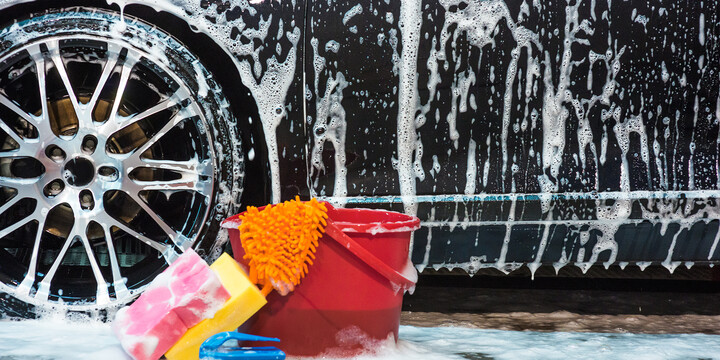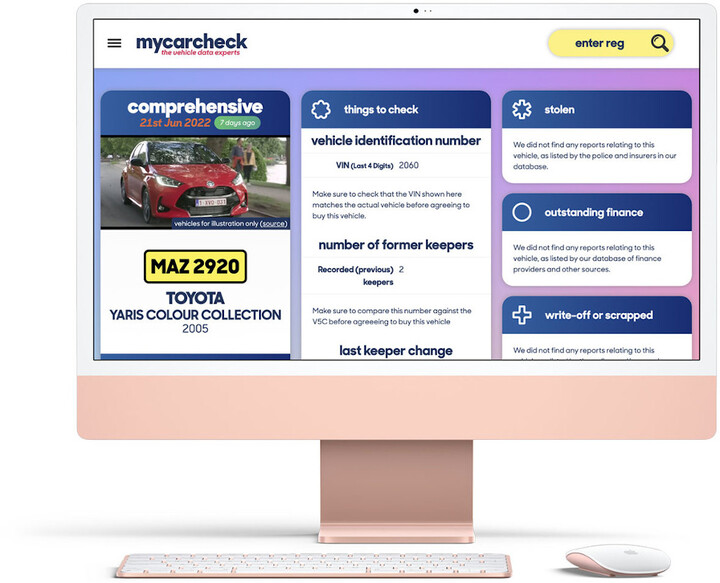
how to maintain your vehicle
FREE Car History Check
See MOT history, valuations, detailed specs and more… AND upgrade to see if any vehicle has been stolen, has finance or has been written off from just £4.99
Whether we like it or not, there is no escaping the fact that owning a car brings with it a number of responsibilities. Along with the paperwork, it must be maintained to a safe and legal standard.
Maintenance doesnt just mean an annual service. As we use our cars, parts wear out or require attention so it is essential your vehicle is checked regularly. Most drivers appreciate that tyres must have sufficient tread depth for your and others safety but some checks can help prevent expensive failures. For example ensuring there is the right amount of oil in a vehicles engine can improve its life (and an engine failure at speed can be dangerous).
We are fortunate that newer cars have warning messages to tell us when some things go wrong but they dont monitor everything and we shouldnt rely on sensors as they can fail too. Nor should we wait for an MOT test as this wont capture issues in the first three years of a cars life or for the 12 months between each test.
This section steps through the areas of essential maintenance from keeping your car clean and basic seasonal checks to looking at some of the more straight-forward mechanical and electrical items.
How to maintain your vehicle tyres
One part of a vehicle many people often fail to check often enough is its tyres. They are the only points of contact with the road so are arguably the most important part of your car. They need to be in good condition with legal tread depth and inflated properly. Driving with the wrong pressure will affect the car’s ride, handling and braking.
Whatever mileage you drive, as an absolute minimum you should do a monthly tyre check. We’d recommend every one or two weeks to ensure your tyres are safe and legal. So what should you be looking for?
Visual check
A visual check is easy and just takes a walk around the car. If you do it regularly, you might spot a potential issue before something serious occurs.
- Does any tyre look under-inflated? Even without a pressure check, if one of the tyres looks softer than the others, it could indicate a slow puncture or that some air has been knocked out when driving over a pothole or bumping up a kerb.
- Are there signs of cracking on the sidewall of the tyre? This would indicate the tyre is old and the rubber could have hardened. This affects grip and can lead to splits. Newer tyres have a date stamp to show age: look for the letters ‘DOT’ and a four digit number showing the week and year of manufacture. So DOT 1016 would mean week 10 (i.e. March) in 2016. Tyres older than 10 years are widely considered unsafe; many manufacturers recommend they are replaced at six years.
- Is there any damage? Deep cuts or even scuffs will weaken a tyre and could indicate internal damage. Also look for any deformities and excessive damage to the wheels themselves which might indicate the tyre has also sustained damage.
- Is the tread depth legal and safe? In the UK the minimum depth is 1.6mm across the middle three quarters of the tyre width. While you can use a tread depth gauge, it is easy to check this visually: the central groove around a tyre will have small, raised markers at various points and these are 1.6mm from the base of the tyre. If they become flush with the rest of the tread, then the tyre is worn to its legal minimum. A tyre’s grip and ability to expel water reduce considerably once a tyre has less than 3mm depth so our recommendation is to replace tyres before they reach 2mm.
Why are pressures important?
Low tyre pressures affect a car’s grip, handling, braking ability and even increase a car’s fuel consumption. Over-inflated tyres will also have a detrimental effect on grip, will make the car’s ride bumpier and can be more liable to punctures. Whether under- or over-inflated, the tyres will wear unevenly across the width. An under-inflated tyre will tend to wear toward the outer edges; over-inflation will wear the centre more.
Checking and altering pressures
Car tyre pressures are usually shown on the inside of the fuel filler cap or will be visible on a sticker on one of the door frames (seen once the door is open). If not, they will be in the owner’s manual. Front and rear pressures sometimes differ (to compensate for the weight of the engine). There are usually two sets of suggested pressures depending on whether the car will be driven empty or fully laden.
Unscrew the dust cap covering each valve and fix on the pressure gauge. If the reading is low, either use a foot pump, small domestic tyre compressor or visit a filling station where there is often an air hose on the forecourt.
If a tyre has been over-inflated, pressing the pin in the centre of the valve (using a small screwdriver or the end of a key) will release the air. Remember to recheck the pressure and add more if you have let too much out.
Also remember to check the spare tyre if one is present. The smaller space-saver types often need inflating to a higher pressure than the regular-sized tyres.
Do remember to replace the dust caps as this will prevent dirt getting into the valves.
Washing and cleaning your car
Keeping your car clean has a number of benefits and while it isn’t everybody’s favourite job on a cold day, it is part of the ownership experience.
Why should I clean my car?
Cleaning your car regularly can help maintain its value. Regularly washing off bird droppings will help keep the paintwork pristine (bird lime has a tendency to stain modern water-based paints). And washing any salt off will also help prolong the bodywork, preventing corrosion especially if the paint has stone chips exposing the bare metal.
Washing a car yourself - rather than taking it to a car wash - will also allow you to look at the vehicle’s condition - stone chips which may need touching in, a peek at the brakes and tyres, a quick check of the oil and washer fluid levels.
How should I go about washing my car?
The important thing is not to scratch the paint by smearing grit as you wash the car so there are some easy steps to avoid this.
Start with an alloy wheel cleaner (while the car is dry) and allow the required number of minutes before washing the chemical off.
Hose or jet wash the worst of the dirt off the car. Be careful with jet washes as even some domestic units are extremely powerful and can damage paint. Start at the roof and work the dirt downwards.
Use a proprietary car shampoo (never washing-up liquid which will strip off any wax on the paint) and a large sponge or dedicated washing mitt to soap the car down. Remember to open the doors, boot and bonnet to wash around the edges properly. Again, start from the top of the car so the dirty suds don’t wash over the clean parts.
Now pay those wheels some attention. There are dedicated brushes and felt blocks available to clean some of the more intricate designs.
Gently hose off the shampoo and check for any missed areas which need to be revisited.
Use a microfibre cloth to mop down the bodywork, wringing it out regularly. Rinse the cloth if it picks up any dirt or this might scratch the paint. Use a second drier microfibre cloth to remove any final drips.
Detailing
Detailing is the term used for putting that extra effort into making your car look pristine. It can mean the difference between merely a clean car and a really smart car. There are dedicated products to improve the appearance of all aspects from the paintwork to the tyres. It isn’t all for the sake of vanity either; a good car wax will have UV protection and can help reduce colour fade for example.
Bodywork - treat your car to a good wax polish every couple of months. It will make the car shine, helps repel dirt and will also make washing easier.
Windows - using a window-cleaning product will keep them smear-free and safer, especially in low sun conditions.
Tyres - some tyre-dressing products include UV protection which will help prevent them cracking as they get older.
Look for details on your car - does it have chromed exhaust finishers which need a polish or an intricate radiator grille which would benefit a clean with a brush to reach the fiddly bits?
Common issues
Fine scratches
These could be caused by grit on a cloth or sponge. Put microfibre cloths in the washing machine to ensure they are clean and rinse any sponges and cleaning mitts properly. If not through a paint or lacquer layer, the scratches can be removed or lessened with a some waxes which have a light cutting action such as Auto Glym’s Resin polish. Deeper scratches can be tackled with a cutting paste such as T-Cut but don’t rub too hard, and buff-off frequently to check you aren’t removing too much paint.
Water marks
On a warm day - or if you haven’t wiped the car down quickly enough - the car can end up with white-ish marks, especially in areas with hard water. These are simply mineral deposits such as calcium. The trick is not to wash your car in the heat of the day or in bright sunlight and to wipe it down quickly once clean. These deposits can usually be washed-off with car shampoo and if necessary, a gentle wax will ensure the paint is restored to its former glory.
Smeary windows or bodywork
It could be oil or grease picked-up from the road. A good car shampoo will shift this. Window cleaning products also work well to help reduce smears on the glass.
How to maintain your vehicles engine
Given appropriate care and maintenance, new cars shouldn’t need much attention outside their main services. However, if something doesn’t feel or sound right - or a dashboard warning light comes on - it is best to contact your garage or recovery service to understand what might be wrong and how urgently it should be fixed. If there is a fault, it is important not to drive your car at all until you understand the cause as this could do considerable (end expensive) damage, cause a danger while driving or both.
Many parts on cars are designed for little or no maintenance at all. Even some gearboxes are described as ‘sealed for life’. This doesn’t mean they can be ignored though. An important part of any car maintenance - especially to the major mechanical parts such as suspension - is about performing a detailed inspection for leaks, damage, corrosion or wear.
Standard maintenance such as oil and filter changes will be part of any service, as will the more detailed inspection of suspension, exhaust, drive train and basic structural integrity. If your car is under warranty, this may be void if you haven’t maintained the car to the manufacturer’s recommended schedule which includes these inspections.
With the increasing complexity of cars, it is becoming harder to service them at home but some older models can still be straight-forward and for those doing high mileages, even basic oil and filter changes can be cost-effective and extend the life of an engine.
If you are planning to maintain your car yourself, it is best to start with a workshop manual which will detail the essential information. This will include the schedule (what needs to be done and when), the methods (how things come apart and go back together again) and the parts themselves (ensuring the correct items are used). It should also list any tools needed.
The key message is only to take on jobs you are confident you can do safely. If you don’t have the knowledge or correct tools, the work is best left to a professional.
You may well entrust the maintenance of your car to a main dealer or local garage for significant work or servicing but this doesn’t stop you attempting some of the smaller jobs. These can save money and time and can bring about a sense of satisfaction. It is often just about being patient and methodical.
Of paramount importance is safety when working on any vehicle. A new car is typically between one and two tonnes and can easily squash a mere human. So if working underneath, the car should be on a firm and level surface and you should make proper use of axle stands. Similarly, if working on an electrical item and the workshop manual advises disconnection of the battery, this is for good reason.
Remember to retain any receipts for parts used as these will be appreciated by the next buyer who can see what work has been done.
How to maintain your vehicle fuses
For safety, electrical circuits in cars are fitted with fuses. These are small replaceable parts containing a thin strip of wire which melts and breaks if the current exceeds a normal, safe level.
Vehicles have a fuse box to access the various fuses linked to the different electrical circuits. If a fuse blows, it is likely to affect one or more components on the same circuit. This can sometimes occur when a single device on the car fails - such as a headlamp bulb - and there is a short current spike. It could be more serious with faulty wiring causing an electrical short circuit to ground (for example where a wire’s insulation becomes worn away and the wire’s core touches the metal bodywork).
Replacing the fuse and checking everything works is the simplest way to see if there is a failure. Fuses can sometimes blow for no apparent reason but if they blow repeatedly, it will indicate a failed component or an electrical short circuit. If there are no obvious failures on the car and the fuse keeps blowing, the car will require some diagnostic checks which can be performed by a garage.
The fuse box is positioned in different location depending on the make and model of your car. It could be under the bonnet, beneath the dashboard or even in the boot. And some cars have more than one. The owner’s manual will indicate where to find the fuse box on your particular car.
In general, older cars use glass tube types; new cars use the flatter blade type. Replacement fuses are available from generic car parts stores as well as dealerships. Remember to replace each blown fuse with one of an identical current rating. Failure to do so could risk overloading a circuit which may lead to an electrical fire.
Note, if you are unsure about the use and operation of fuses - or any of your car’s electrical systems - seek a qualified professional.
How to maintain your cars oil and fluids
Modern cars tend to have long service intervals (typically one year or 20,000 miles). This means it can be a considerable time between garage visits so it is essential to check the levels of the various fluids. Even if your car is under warranty, if you are found to have driven with insufficient oil in the engine for example, this would be considered negligence on your part and the manufacturer wouldn’t necessarily pay out in the event of an engine failure.
It also makes sense to look on the ground where you regularly park your car. Spotting a small leak before it has become a big leak means you can have the problem addressed before any damage is done. Worse, if your car is losing brake fluid, being unable to stop could lead to a serious accident.
Modern engines have sensors for many of the fluids so it is important to take heed of any warning symbols or messages on the dashboard. Sensors can fail though so a manual check is still a good idea.
What should you check?
The following key items should be checked. They should be straight-forward and are usually obvious once the bonnet is lifted. If you are unsure of the locations, please refer to your car’s manual.
Safety first: all of these checks should be made with the engine switched off and the keys safely away from the ignition so nobody can start the car with your hands around the engine bay.
Engine oil. This is checked using a dipstick which shows how much oil is in the sump at the bottom of the engine. Oil should be checked when the engine hasn’t just been run because the oil will be spread around the engine (rather than sitting in the sump) and it could be too hot to touch. Also ensure the car is parked on a level surface for a more accurate reading.
Checking needs the dipstick to be cleaned first. Remove it fully and wipe it clear of oil with a clean, lint-free cloth or paper towel. The dipstick then needs to be re-inserted fully and removed once again. The oil level should be between the min and max markers. If the reading is low, it could indicate a leak or that the engine is worn and burning the oil. Top up as necessary with the correct grade of oil. This is done through a separate filling point, usually on the top of the engine.
Coolant. If the car has a transparent expansion tank, this just needs a visual check to ensure the coolant is between the min and max level markers. Some cars require the cap on the radiator to be removed to view it so remember to wait for the engine to cool fully before doing this. Coolant (also known as antifreeze because it does both jobs) comprises an additive in addition to water. If the level is low, it will require the correct mix to be added. A constant need to top up indicates a leak which should be investigated.
Brake fluid. This can be checked by looking at the level on the side of the header reservoir. If it isn’t a clear plastic type, it should have a cap with inbuilt dipstick to show how full it is. The level will drop slightly as the brake pads wear but should remain above the minimum marker. Your car will need urgent checks if the level drops significantly.
Power steering fluid. Like brake fluid, there will be a reservoir which can be checked either visually or with a dipstick.
Windscreen washer fluid. It is an offence to drive with an empty washer bottle as this could prevent you cleaning the screen properly when on the move. It isn’t always easy to see how much is left in the washer bottle so some cars have warning systems. It makes sense to top this up regularly and if you are driving on longer journeys, it is good practice to keep a spare bottle in the boot. It is available in pre-mixed form or concentrate. Concentrate can work out cheaper and allows you to alter the mix ratio, for example making it stronger in the winter to prevent freezing.
There are other fluids in your car such as clutch fluid and automatic transmission fluid. These would generally be checked at the appropriate intervals when it is being serviced.














